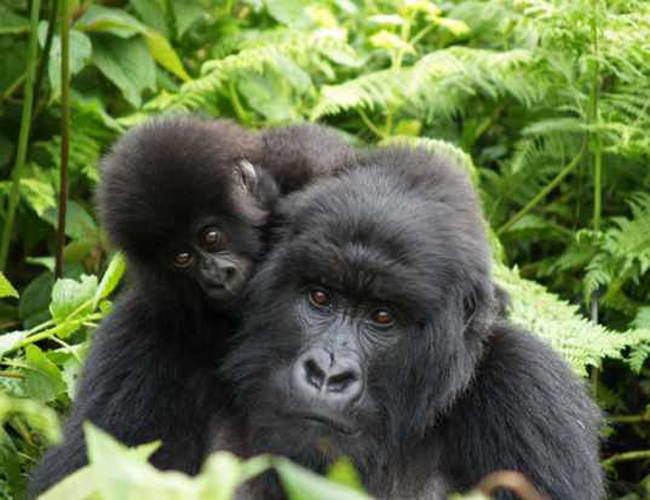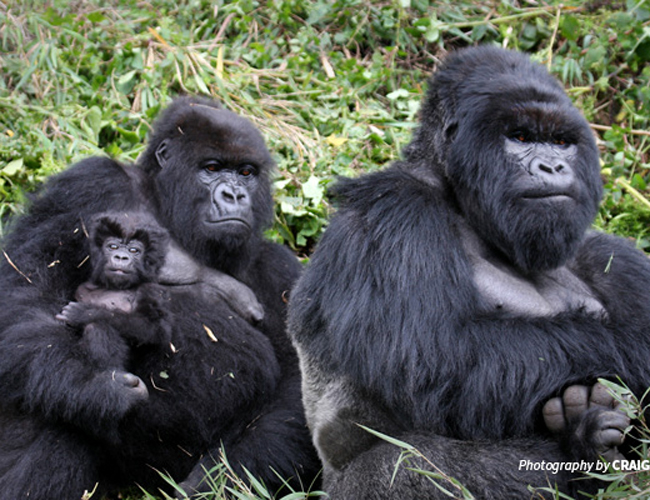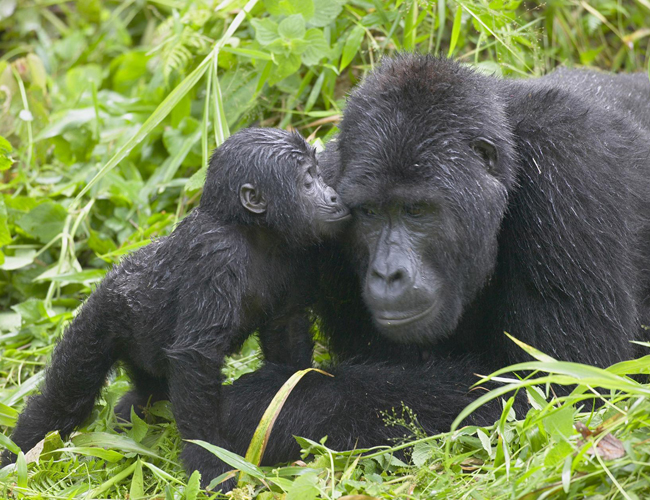







The Mountain Gorilla
The mountain gorilla (Gorilla beringei beringei) is one of two subspecies of the eastern gorilla
(Gorilla beringei). The mountain gorilla is primarily terrestrial and quadrupedal. However, it will climb into fruiting trees if the branches can
carry its weight, and it is capable of running bipedally up to 6 m (20 ft). The mountain gorilla is diurnal,
most active between 6:00 a.m. and 6:00 p.m. Many of these hours are spent eating, as large quantities of food
are needed to sustain its massive bulk. It forages in early morning, rests during the late morning and around
midday, and in the afternoon it forages again before resting at night. Each gorilla builds a nest from
surrounding vegetation to sleep in, constructing a new one every evening. Only infants sleep in the same
nest as their mothers. They leave their sleeping sites when the sun rises at around 6 am, except when it
is cold and overcast; then they often stay longer in their nests.
Population: It is listed as endangered on the IUCN Red List, as the total population is
estimated to comprise 1,004 individuals in two populations as of 2018.
Location: One population lives in Uganda's Bwindi Impenetrable National Park, and the other in
the Virunga Mountains in three adjacent national parks, namely Uganda's Mgahinga Gorilla National Park,
Rwanda's Volcanoes National Park, and Virunga National Park in the Democratic Republic of Congo.
Appearance: The fur of the mountain gorilla,often thicker and longer than that of other gorilla species,
enables them to live in colder temperatures. Gorillas can be identified by nose prints unique to each individual.
Males, at a mean weight of 195 kg(430 lb) upright standing height of 168 cm (66 in) usually weigh twice as
much as the females, at a mean of 100 kg (220 lb) and a height of 140 cm (55 in). This subspecies is smaller
than the eastern lowland gorilla, the other subspecies of eastern gorilla. Adult males have more pronounced
bony crests on the very top and back of their skulls, giving their heads a more conical shape.
Habitat: The mountain gorilla inhabits the Albertine Rift montane cloud forests and of the Virunga
Volcanoes, ranging in altitude from 2,200–4,300 metres (7,200–14,100 ft). Most are found on the slopes of three of the dormant
volcanoes: Karisimbi, Mikeno, and Visoke. The vegetation is very dense at the bottom of the mountains, becoming more sparse
at higher elevations, and the forests where the mountain gorilla lives are often cloudy, misty and cold. The home range size
(the area used by one group of gorillas during one year) is influenced by availability of food sources and usually includes
several vegetation zones. George Schaller identified ten distinct zones, including: the bamboo forests at 2,200–2,800 metres
(7,200–9,200 ft); the Hagenia forests at 2,800–3,400 metres (9,200–11,200 ft); and the giant senecio zone at 3,400–4,300 metres
(11,200–14,100 ft). The mountain gorilla spends most of its time in the Hagenia forests, where galium vines are found year-round.
Diet: The mountain gorilla is primarily a herbivore; the majority of its diet is composed of
the leaves, shoots and stems (85.8%) of 142 plant species. It also feeds on bark (6.9%), roots (3.3%), flowers (2.3%),
and fruit (1.7%), as well as small invertebrates. (0.1%). Adult males can eat up to 34 kilograms (75 lb) of vegetation
a day, while a female can eat as much as 18 kilograms (40 lb). All parts of this vine are consumed: leaves, stems, flowers,
and berries. It travels to the bamboo forests during the few months of the year fresh shoots are available, and it climbs into
subalpine regions to eat the soft centers of giant senecio trees.